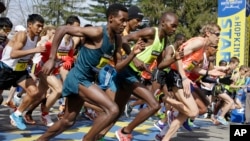BYRD: Let’s run down some of the more common injuries or irritations that runners might run into. One of the first ones is runner’s knee. What is runner’s knee and how can you tell if you have it?
OCHIAI: Runner’s knee could encompass a couple of different things: one is a tightness of your iliotibial band. So you feel it more on the side of your knee and it will be tender to touch like right over the bone on the outside of your knee. It’s related to having a really tight iliotibial band, which is pretty common in a distance runner. Another could be in the front of your knee – like when you sit down it’s directly in front of your knee where you are feeling the tenderness – that would be patellar tendinitis, inflammation of the tendon that attaches you knee cap to your shin bone. It will be tender to touch. You may have some pain when you try to forcefully extend your knee or straighten it out.
BYRD: What about something on the back of your leg, in the hamstring muscles: are there issues there too that people should be aware of?
OCHIAI: Oh absolutely. The distance runners have a tendency to be rather on the less flexible side. A lot of times distance runners can tend to have tightness of their hamstring tendons and their hamstrings go down the back (of the leg) and then wrap around the front of the knee. You can definitely have some irritation there. In addition you may get some swelling in the back of the knee that comes and goes intermittently. That’s called a ‘baker’s cyst' and that’s some joint fluid that’s leaking out the back of your knee and causing intermittent swelling there.
BYRD: How can somebody know when it’s just an irritation and when it’s time to come visit someone like you or maybe a physical therapist? What are some signs of a more serious injury where a runner would need to go see a physician?
OCHIAI: If it is something that’s stopping you from running, if you’re trying to run and you start feeling a sharp pain and it’s making you limp, those are signs that you should probably see someone who can evaluate you for possible stress fractures and things like that which can happen when you have a rapid change in activity level.
If you would like to learn more about running injuries and what to do for them check our Dr. Derek Ochiai's homepage.
OCHIAI: Runner’s knee could encompass a couple of different things: one is a tightness of your iliotibial band. So you feel it more on the side of your knee and it will be tender to touch like right over the bone on the outside of your knee. It’s related to having a really tight iliotibial band, which is pretty common in a distance runner. Another could be in the front of your knee – like when you sit down it’s directly in front of your knee where you are feeling the tenderness – that would be patellar tendinitis, inflammation of the tendon that attaches you knee cap to your shin bone. It will be tender to touch. You may have some pain when you try to forcefully extend your knee or straighten it out.
BYRD: What about something on the back of your leg, in the hamstring muscles: are there issues there too that people should be aware of?
OCHIAI: Oh absolutely. The distance runners have a tendency to be rather on the less flexible side. A lot of times distance runners can tend to have tightness of their hamstring tendons and their hamstrings go down the back (of the leg) and then wrap around the front of the knee. You can definitely have some irritation there. In addition you may get some swelling in the back of the knee that comes and goes intermittently. That’s called a ‘baker’s cyst' and that’s some joint fluid that’s leaking out the back of your knee and causing intermittent swelling there.
BYRD: How can somebody know when it’s just an irritation and when it’s time to come visit someone like you or maybe a physical therapist? What are some signs of a more serious injury where a runner would need to go see a physician?
OCHIAI: If it is something that’s stopping you from running, if you’re trying to run and you start feeling a sharp pain and it’s making you limp, those are signs that you should probably see someone who can evaluate you for possible stress fractures and things like that which can happen when you have a rapid change in activity level.
If you would like to learn more about running injuries and what to do for them check our Dr. Derek Ochiai's homepage.




